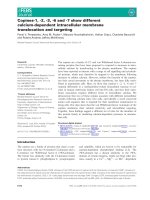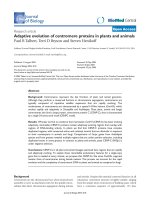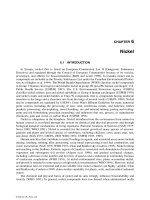2 3 plants and animals (life science)
Bạn đang xem bản rút gọn của tài liệu. Xem và tải ngay bản đầy đủ của tài liệu tại đây (2.33 MB, 14 trang )
Genre
Nonfiction
Comprehension Skill
Cause and Effect
Text Features
• Captions
• Diagram
• Glossary
Science Content
Plants and
Animals
Scott Foresman Science 2.3
ISBN 0-328-13776-6
ì<(sk$m)=bdh gd< +^-Ä-U-Ä-U
Vocabulary
consumer
food chain
food web
predator
prey
producer
Picture Credits
Every effort has been made to secure permission and provide appropriate credit for photographic material.
The publisher deeply regrets any omission and pledges to correct errors called to its attention in subsequent editions.
Photo locators denoted as follows: Top (T), Center (C), Bottom (B), Left (L), Right (R), Background (Bkgd).
2 Andrew Plumptre/Photolibrary/OSF Limited; 7 Tom Vezo/Peter Arnold, Inc.; 8 Ferrero-Labat /Peter Arnold, Inc.;
9 (CR) ©Rick and Nora Bowers/Visuals Unlimited; 13 (BL) ©Darren Bennett/Animals Animals/Earth Scenes;
14 (BL) Amos Nachoum/Corbis; 15 (TR) Amos Nachoum/Corbis, (CL) ©Oxford University Museum/DK Images;
16 Alexis Rosenfeld/Photo Researchers, Inc.; 17 (C) Alexis Rosenfeld/Photo Researchers, Inc.;
18 Mark Moffett/Minden Pictures; 19 (B) © Gilbert Twiest /Visuals Unlimited; 21 Heather Angel/Natural Visions;
22 ©Steve Hopkin/Ardea.
Scott Foresman/Dorling Kindersley would also like to thank: 15 (CLA) Stephen Oliver/DK Images.
Unless otherwise acknowledged, all photographs are the copyright © of Dorling Kindersley, a division of Pearson.
ISBN: 0-328-13776-6
Copyright © Pearson Education, Inc. All Rights Reserved. Printed in the United States of America.
This publication is protected by Copyright, and permission should be obtained from the publisher prior to any
prohibited reproduction, storage in a retrieval system, or transmission in any form by any means, electronic,
mechanical, photocopying, recording, or likewise. For information regarding permission(s), write to
Permissions Department, Scott Foresman, 1900 East Lake Avenue, Glenview, Illinois 60025.
3 4 5 6 7 8 9 10 V010 13 12 11 10 09 08 07 06 05
What did you learn?
1. What is the difference between
a producer and a consumer?
2. What can animals use to
build nests?
3.
Energy moves
through a food chain. Write to
Evan Allen
explain how itby
moves.
Use words
from the book as you write.
4.
Cause and Effect What
happens when habitats cannot
meet the needs of the plants and
animals that live there?
Plants and Animals
Have Needs
Plants and animals both need air. They both
need water. They both need space. All living
things need food.
Plants and animals are living things.
All living things have needs. Needs can
be different for different living things. Plants
need light from the Sun. Animals need shelter.
All living things share some needs.
2
3
Some living things can make their own food.
They are called producers. Plants are producers.
They use light from the Sun to make food in their
leaves and stems. Green plants can make food.
Some living things cannot make food inside
their own bodies. They are called consumers.
Consumers look for food in their habitats.
Animals are consumers.
Cows need grass to eat.
4
5
Different Needs
Different animals have different needs.
Big animals need more food, water, and space.
Small animals need less food, water, and space.
Plants and animals share habitats.
They help each other to get what
they need.
Sometimes habitats do not have
enough food. When this happens
some animals might die.
A gilded flicker
nests in a cactus.
Which of these animals
needs more space?
6
7
Getting Food
In a Grassland
Food chains show how living things get food.
All food chains start with the Sun. Plants use
energy from the Sun to make food. Animals eat
those plants. Other animals eat those animals.
These are the steps of a food chain.
grass
gazelles grazing in
a grassland habitat
prairie dog
black-footed ferret
Energy passes from the Sun to the blackfooted ferret in this food chain. Animals in
food chains can be predators or prey. Predators
catch and eat other animals. The animals they
eat are prey.
8
9
Sun
daisy
butterfly
skink
Energy moves in the steps of
a food chain. Look at the grassland
food chain above. Energy goes from
the Sun to a daisy plant.
10
A butterfly feeds on the daisy. The butterfly
gets energy too. A skink eats the butterfly.
The skink gets energy. The energy has moved
from the Sun to the skink.
11
Food Web in a Grassland
Habitats can have more than one food chain.
Grasslands have more than one food chain.
All the food chains in a grassland make up
a food web.
Look at the picture of a grassland food web.
The Sun helps plants make food. Some animals
eat the plants. Other animals eat those animals.
Follow the arrows to see the
different food chains.
raccoon
hawk
vole
mountain lion
coyote
corn plant
12
fox
13
Getting Food
In an Ocean
seal
An ocean is another habitat. Many plants
and animals live there. These plants and animals
get energy through food chains.
Look at the ocean food chain below.
What animals are part of this food chain?
zooplankton
14
starfish
crab
sea urchin
mussels
orca
orca
sea gull
codfish
kelp
Ocean food chains make up food webs.
Look at the plants and animals. How does
energy move from the Sun to the orca?
15
Food Webs
Can Change
People can change food webs. When people
throw trash in the ocean they hurt ocean food
webs. People can help too. It helps when people
try to keep the ocean clean.
Lots of things can change a food web.
Some changes can be bad. They hurt
the plants and animals in the food web.
16
17
Plants and Animals
Help Each Other
Plants and animals can help each other.
These wasps are getting food from a fig.
young fig wasps
feeding on a fig
18
Yucca moths help yucca plants. They take
pollen from plant to plant. This helps new
plants grow.
Yucca plants help yucca moths. The moths
lay their eggs in the plants. When they hatch,
the young moths find shelter
in the plant.
Yucca plants and yucca
moths help each other.
19
Animals Need Each Other
Animals need each other in many ways.
Animals work together. They can protect each
other. They can feed each other. They can give
each other a place to live.
The oxpecker eats ticks that live on the rhino’s
back. This keeps the rhino clean. The rhino and
the oxpecker need each other.
Building Nests
Animals can use parts of plants and other
animals to build nests. They can use leaves.
They can use feathers.
What parts of plants and animals do you see
in this nest?
20
21
Dairy ants and aphids live together and
help each other. The ants keep predators
away from the aphids. The aphids make
honeydew. The honeydew is a sweet treat
for the ants to eat.
Plants and animals live together.
They share needs. Living things help
each other in many ways.
dairy ant
aphid
22
23
Vocabulary
Glossary
consumer
food chain
consumer
food web
predator
preychain
food
producer
a living thing that eats other
living things
how living things get energy
from food
food web
more than one food chain
in one place
predator
an animal that hunts and eats
other animals
prey
animals that are hunted
for food
Picture Credits
Every effort has been made to secure permission and provide appropriate credit for photographic material.
The publisher deeply regrets any omission and pledges to correct errors called to its attention in subsequent editions.
Photo locators denoted as follows: Top (T), Center (C), Bottom (B), Left (L), Right (R), Background (Bkgd).
2 Andrew Plumptre/Photolibrary/OSF Limited; 7 Tom Vezo/Peter Arnold, Inc.; 8 Ferrero-Labat /Peter Arnold, Inc.;
9 (CR) ©Rick and Nora Bowers/Visuals Unlimited; 13 (BL) ©Darren Bennett/Animals Animals/Earth Scenes;
14 (BL) Amos Nachoum/Corbis; 15 (TR) Amos Nachoum/Corbis, (CL) ©Oxford University Museum/DK Images;
16 Alexis Rosenfeld/Photo Researchers, Inc.; 17 (C) Alexis Rosenfeld/Photo Researchers, Inc.;
18 Mark Moffett/Minden Pictures; 19 (B) © Gilbert Twiest /Visuals Unlimited; 21 Heather Angel/Natural Visions;
22 ©Steve Hopkin/Ardea.
producer
a living thing that makes its
own food
Scott Foresman/Dorling Kindersley would also like to thank: 15 (CLA) Stephen Oliver/DK Images.
Unless otherwise acknowledged, all photographs are the copyright © of Dorling Kindersley, a division of Pearson.
ISBN: 0-328-13776-6
Copyright © Pearson Education, Inc. All Rights Reserved. Printed in the United States of America.
This publication is protected by Copyright, and permission should be obtained from the publisher prior to any
prohibited reproduction, storage in a retrieval system, or transmission in any form by any means, electronic,
mechanical, photocopying, recording, or likewise. For information regarding permission(s), write to
Permissions Department, Scott Foresman, 1900 East Lake Avenue, Glenview, Illinois 60025.
24
3 4 5 6 7 8 9 10 V010 13 12 11 10 09 08 07 06 05
What did you learn?
1. What is the difference between
a producer and a consumer?
2. What can animals use to
build nests?
3.
Energy moves
through a food chain. Write to
explain how it moves. Use words
from the book as you write.
4.
Cause and Effect What
happens when habitats cannot
meet the needs of the plants and
animals that live there?









